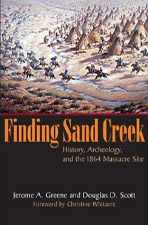Book Review
Finding Sand Creek: History, Archaeology, and the 1864 Massacre Site
By Jerome A. Greene and Douglas D. Scott. Norman: University of Oklahoma Press, 2004; illustrations, maps, index, 241 pp.; cloth $24.95.
 |
In early January, at the annual meeting of the Society of Historical Archaeology in Sacramento, California, a historian told a room full of archeologists and historians that the two groups do not pay any attention to each other. According to him, each profession thinks the other is rife with particularists and therefore is not worthy of attention.
The man has obviously never read this fine study by Jerry Greene and Doug Scott, two of the best in their respective professions. The project that culminated in the location of the village massacred by the Third Colorado Volunteers commanded by Colonel John M. Chivington on November 29, 1869, could not have been successful without the cooperation, mutual respect, and deep admiration these two professionals have for each other and the dozens of people who worked with them.
Before I launch into my generally glowing review of their book, I must come clean. I am somewhat biased because I helped get this project off the ground. The day that then United States Senator Ben Nighthorse Campbell introduced a bill to create a unit of the National Park System commemorating this massacre of more than 150 Cheyenne and Arapaho men, women, and children, I advised my boss at the time, Jerry Rogers, that he might want to call Washington and warn them that we did not know where the site of that massacre was. When the bill was passed that fall, it was renamed the Sand Creek Massacre Site Study Act of 1998, and it directed the National Park Service to work with the State of Colorado and the Cheyenne and Arapaho tribes to identify the location and extent of the Sand Creek Massacre Site and to make recommendations on whether it should become a unit of the National Park System. Finding Sand Creek is the culmination of an exemplary interdisciplinary study that I am proud to have touched early in its process.
The book is organized into four very easy-to-read sections. The first part is a succinct and well-told historical overview of the context of the massacre, and the events leading directly up to the event, what occurred during the massacre, and Commander Chivington's movements immediately afterwards. Jerry Greene, the pre-eminent military historian on this team, explains the immediate negative significance of the massacre to Cheyenne social and political relationships and to Indian-white relationships in general. The massacre fragmented the Dog Warrior Society and created a lasting distrust of the Army, which swept throughout all the Plains tribes, escalating hostilities that continued for the rest of the century. Greene believes that echoes of this distrust remain in government-to-government relationships between tribes and the United States government to this day.
In the second part, Greene and Scott walk us through the historical documentation used to estimate the location of the massacre site, which had become confused over the years. Most valuable in this search was a map made by Second Lieutenant Samuel W. Bonsall, who visited the site in June 1868, four years after the massacre. His work constitutes the earliest, detailed map made of the massacre location, which placed it about six miles below a three-way fork in a trail. This fork was visible on a series of Soil Conservation Service aerial photographs from the 1930s.
The third part of Finding Sand Creek consists of a description of the National Park Service's archeological work. Scott's 1999 archeological team began a systematic metal-detector sweep north of the traditionally held location, which had already yielded a modest amount of munitions. When his crew arrived about a quarter of a mile east of the position predicted by Greene and the aerial photography analyst, they found an abundance of artifacts dating to the early 1860s that included domestic items (coffee pots, buckets, kettles, spoons, forks, and cans), tools (files, hammers, and axes), personal items (suspender grips, buttons, thimbles, and tinklers), and horse equipage. All were consistent with the types of supplies issued to American Indian villages in the late 1850s and 1860s.
Most telling, however, was that the ammunition was consistent with what was known to be used by the Third Colorado Volunteers and the telltale 12-pound case shot fragments fired from Chivington's mountain howitzers. The domestic wares had all been broken, thus confirming the Army reports that the volunteers had destroyed the Indians' supplies to impoverish the survivors. Together, the archeologists believed they had discovered powerful evidence of the location of the village site.
The fourth part of the book returns to the historic documentation, offering two maps prepared by survivor George Bent and reinterpreting them based on the archeological evidence. The authors find that the maps make perfect sense, when proportion and scale are ignored.
Finding Sand Creek appendices describe the hundreds of metal artifacts recovered and list common goods issued to tribes during that time to demonstrate how the artifact inventory mimics the known types of items that should have been in the village.
The only weakness of this collaborative effort is the failure to include the Cheyenne and Arapaho oral histories. In terms of timing and tone, perhaps it is too much to ask of this type of study. The authors make a well-articulated point that some of the descendants of survivors and victims of the massacre disagree with the archeological and historical interpretation of the evidence. Greene and Scott do a credible job of explaining the reasons for that difference of opinion, and as team leader Christine Whitacre reminds the reader, the legislated boundaries of the subsequently established National Historic Site are large enough to encompass the historically, archeologically, and traditionally held locations of the site. Even so, a similarly high quality volume on the oral histories would make a good companion to Finding Sand Creek.
Catherine Spude
National Park Service (ret.)
